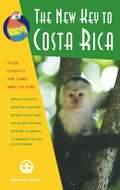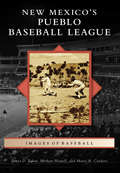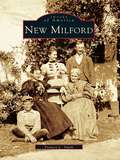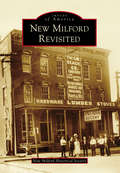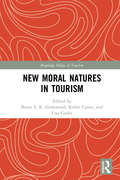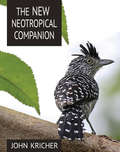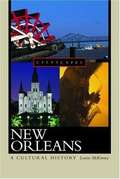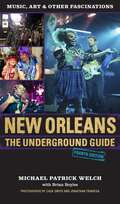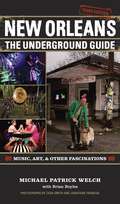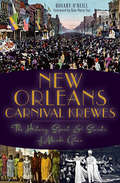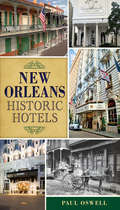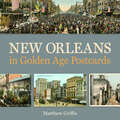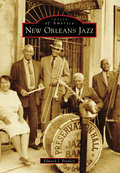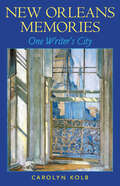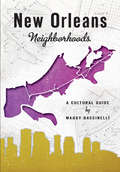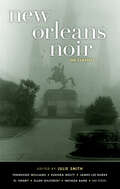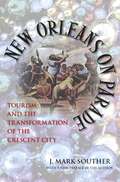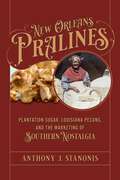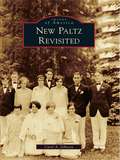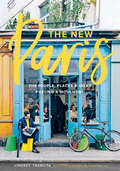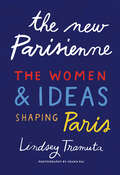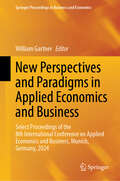- Table View
- List View
The New Key to Costa Rica
by Beatrice BlakeOver 400,000 copies sold of previous editions The original guide to Costa Rica, updated with even more insider hints, tips and secrets Features extensive travel information plus in-depth coverage of the natural environment and advice on how to benefit the local economy and conservation efforts Recommends and details over 50 hotels that practice sustainable tourism Written by a dedicated conservationist who lived in Costa Rica for 12 years Covers the entire country from 44 beaches on two oceans to 38 national parks, 13 volcanoes, and three cloud forests Shows how to enjoy Costa Rica's natural beauty and ecology in a socially responsible way
The New Malaysian House
by Robert Powell Albert Lim KsThe New Malaysian House is a collection of 25 contemporary houses that demonstrate a remarkable flowering of Malaysian design talent that has been germinating since the mid- 1980s. The houses range from luxury detached bungalows set in extensive tropical gardens to weekend retreats in the forest, from the gated communities springing up throughout Malaysia to extended family homes. All are distinguished by a singular quality of innovative design as the architects sought to explore new approaches for designing with the climate and in the cultural context of Malaysia.
New Mexico! (Wagons West Series, Book #22)
by Dana Fuller RossThe hostile desert and hidden arroyos offered cover to a roving band of killers. No soldiers could catch them; no settlers resist them. So upon the broad shoulders of Toby Holt, son of the West's greatest trailblazer Whip Holt, would be laid a desperate burden--to travel into this no-man's-land and infiltrate the deadly gang. And as Toby left behind his beloved Alexandra, perhaps forever, his friend Henry Blake would wrench himself from a Baroness' arms to thwart a deadly plot abroad. But no one faced more peril than the brave young woman photographer whose indomitable American spirit fueled her courage to survive captivity among the fiercest savages... as Toby Holt raised his rifle to fire in the name of justice in this land of blood and honor-- NEW MEXICO!
New Mexico’s Pueblo Baseball League (Images of Baseball)
by Herbert Howell James D. Baker Marie A. CorderoBaseball began in the New Mexico pueblos before 1900. The game was learned by watching soldiers and settlers and by playing in the Indian schools throughout the country. The first competition was with Albuquerque teams, mining teams, other pueblo teams, and the state penitentiary. Today, the game has evolved into a family and tribal tradition. The games are played on barren fields with enthusiastic spectator support. The players' objective is to win that game, with little thought of individual achievement; they are playing for family and tribe.
New Milford (Images of America)
by Frances L. SmithNew Milford is located in western Connecticut, in the lower portion of Litchfield County. The originalinhabitants of the area were the Potatuck who, along with other tribes, retreated as settlement of the region began--the first in the county being in Woodbury in 1672. At the beginning of the eighteenth century, the land that later became New Milford was purchased from the Indians, and the first settler, John Noble, arrived from Massachusetts and built a home here in 1707. As the centuries progressed, so did the town. New Milford became a business center with many mills, shops, taverns, and other services.In stunning images and clear narrative, New Milfordtraces the history not only of the town itself but also of many of the families whose names are an integral part of the community, among them the Bostwicks, the Heacocks, and the Kings. The book follows the development of the town--its industry, such as New Milford Pottery, its educationalfacilities, such as Canterbury School, and its familiar places, such as the Wayside Inn.
New Milford Revisited
by New Milford Historical SocietyCovering 64 square miles, New Milford is the largest municipality in Connecticut and the southernmost town in Litchfield County. Earliest residents settled around the present-day Village Green, making it the epicenter of town. In the early 1900s, a great fire obliterated a good portion of the downtown buildings, but businesses were quickly resurrected. Establishments such as the Robertson Bleachery, Eastern Lounge, and New Milford Foundry & Machine helped the town rise from the ashes. The 20th century also saw the demise of the tobacco industry that had dominated the area for decades, as several businesses, mostly located in the West Street area, rose to prominence. In later years, Kimberly-Clark Corporation, Maggi Company (which would merge with Nestlé), Scovill Manufacturing, Century Brass, and New Milford Hospital all thrived as the town prospered. New Milford's iconic bandstand has been the scene of numerous concerts, including one in 1960 conducted by longtime resident Maestro Leopold Stokowski, and the structure has graced the cover of the Saturday Evening Post. It is no surprise that Fredric March, Vladimir Horowitz, Joan Rivers, Diane von Furstenberg, Eartha Kitt, and Ruth and Skitch Henderson have all chosen New Milford as home.
New Moral Natures in Tourism (Routledge Research in the Ethics of Tourism Series)
by Bryan S. Grimwood Kellee Caton Lisa CookeHow do we understand human-nature relationships in tourism, or determine the consequences of these relationships to be "good," "bad," "right," "wrong," "fair," or "just"? What theoretical and philosophical perspectives can usefully orient us in the production and consumption of tourism towards living and enacting the "good life" with the more-than-human world? <P><P>This book addresses such questions by investigating relationships between nature and morality in tourism contexts. Recognizing that morality, much like nature, is embedded in histories and landscapes of power, the book engages with diverse theoretical and philosophical perspectives to critically review, appraise, and advance dialogue on the moral dimensions of natures. Contributing authors explore the very foundations of how we make sense of nature in tourism and leisure contexts—and how we might make sense of it differently. <P><P>The book will be essential reading for researchers, students, and practitioners grappling with questions about the moral values, frameworks, or practices best suited to mobilizing tourism natures. What will the future of tourism hold in terms of sustainability, justice, resilience, health, and well-being?
The New Neotropical Companion
by John KricherThe New Neotropical Companion is the completely revised and expanded edition of a book that has helped thousands of people to understand the complex ecology and natural history of the most species-rich area on Earth, the American tropics. Featuring stunning color photos throughout, it is a sweeping and cutting-edge account of tropical ecology that includes not only tropical rain forests but also other ecosystems such as cloud forests, rivers, savannas, and mountains. This is the only guide to the American tropics that is all-inclusive, encompassing the entire region's ecology and the amazing relationships among species rather than focusing just on species identification.The New Neotropical Companion is a book unlike any other. Here, you will learn how to recognize distinctive ecological patterns of rain forests and other habitats and to interpret how these remarkable ecosystems function—everything is explained in clear and engaging prose free of jargon. You will also be introduced to the region's astonishing plant and animal life.Informative and entertaining, The New Neotropical Companion is a pleasurable escape for armchair naturalists, and visitors to the American tropics will want to refer to this book before, during, and after their trip.Covers all of tropical AmericaDescribes the species and habitats most likely to be observed by visitorsIncludes every major ecosystem, from lowland rain forests to the high AndesFeatures a wealth of color photos of habitats, plants, and animals
New Orleans: A Cultural History
by Louise MckinneyFounded in 1718 by two French-Canadian brothers for French King Louis XIV, New Orleans grew from its roots as a Euro-Caribbean port city at the nexus of North, Central and South America. Situated at the bottom of the Mississippi River Delta, the city became "Paris on the Mississippi," the fashionable cultural capital of the American South, home to America's first opera house and birthplace of jazz. Many think of New Orleans, with its antebellum mansions, above-ground cemeteries and ghostly moss-bearded oaks as a haunted place. It is certainly the most un-American of American cities, creating its own laid-back "Big Easy" attitude from the customs of the people who founded it: French and Spanish colonists, gens de couleur libres, Northern adventurers, riverboat men, pirates, and Cajuns. From this eclectic mix of influences has evolved a distinctive Creole culture, expressed in language, architecture and cuisine. Louise McKinney explores the soul of this deeply spiritual and hedonistic place, where every year the pre-Lenten Mardi Gras bursts forth with outrageous excess.
New Orleans: The Underground Guide, 4th Edition
by Michael Patrick Welch Brian Boyles Zack Smith Jonathan TraviesaNew Orleans: The Underground Guide shows visitors how to experience the Big Easy like a local, looking past staples like beignets and Bourbon Street to reveal a city bursting with contemporary and experimental art, genre-busting DJs, international cuisines, and even kid-friendly activities.This fully updated edition offers an expansive collection of alternative recommendations for exploring the city of Mardi Gras, brass bands, and weekly festivals. Featuring over two hundred new entries on local bands, rappers, restaurants with live music, galleries, and more, this guidebook takes readers on a one-of-a-kind journey through New Orleans, giving advice on everything from what thrift stores and bookshops to visit to what bands to catch in concert and what parades to attend.Lead author Michael Patrick Welch provides a detailed guide of the less traditional, more adventurous side of New Orleans, from bars that hold readings of poetry and erotic literature to costume shops that sell handmade masks, party supplies, and all the parade throws you can carry. Drawing on the wisdom of New Orleans celebrities, journalists, artists, and musicians from throughout the Crescent City, the fourth edition of New Orleans: The Underground Guide is an authentic and reliable resource for where locals listen to music, art hop, shop, eat, drink, and let loose.
New Orleans: The Underground Guide, 4th Edition
by Michael Patrick Welch Brian Boyles Zack Smith Jonathan TraviesaRed beans and rice, trad jazz, and second lines are the Big Easy's calling cards, but beyond where the carriage rides take you is a city brimming with genre-defying music, transnational cuisine, and pockets of wild, artistic locals that challenge preconceived notions of what it means to be New Orleans. With a respectful nod to the traditional and a full embrace of the obscure, New Orleans: The Underground Guide is a resource for discovering the city as it really is -- as much brass bands and boas as it is bounce and bicycle tours. From a speakeasy in the Bywater neighborhood to the delightfully sketchy vibe of St. Roch Tavern, lead author Michael Patrick Welch uncovers an unexpected tableau of musicians, venues, and novel ways to pass the bon temps. Contents include but are not limited to: where to get naked, how to make the most of Mardi Gras according to banjo player Geoff Douville, what to order from the delicious Slavic menu at Siberia, where to find the New Orleans Giant Puppet Festival, how to catch a performance by the New Movement comedy troupe, where to rent a kayak, and how to get in on the "bed and beverage" experience at the Royal Street Inn.
New Orleans Carnival Krewes: The History, Spirit & Secrets of Mardi Gras
by Rosary O'Neill&“The traditions, the secret societies and the history of how New Orleans and Mardi Gras came to be as integral to each other as red beans and rice&” (Blogcritics). New Orleans is practically synonymous with Mardi Gras. Both evoke the parades, the beads, the costumes, the food—the pomp and circumstance. The carnival krewes are the backbone of this Big Easy tradition. Every year, different krewes put on extravagant parties and celebrations to commemorate the beginning of the Lenten season. Historic krewes like Comus, Rex, and Zulu that date back generations are intertwined with the greater history of New Orleans itself. Today, new krewes are inaugurated and widen a once exclusive part of New Orleans society. Through careful and detailed research of over three hundred sources, including fifty interviews with members of these organizations, author and New Orleans native Rosary O&’Neill explores this storied institution, its antebellum roots and its effects in the twenty-first century. Includes photos! &“[A] spirited and richly illustrated account.&” —New York Theatre Wire
New Orleans Historic Hotels (Landmarks)
by Paul OswellThe hotels of New Orleans have welcomed countless visitors in a history stretching back to the eighteenth century. From humble boardinghouse beginnings to the grand hotels of the nineteenth century and through to the modern properties that stand today, hotel life in New Orleans has reflected the city's own story. From political scandal and celebrity intrigue to events that shaped the landscape of the entire country, the story of New Orleans's hotels is an endlessly engaging one. Travel writer Paul Oswell checks into the great hotels of the past and the present, telling the story of the properties that stood the test of time, as well as those that didn't. Using city records, newspaper archives, vintage travel guides and anecdotal stories in the best New Orleans tradition, he brings each one to life and in the process fleshes out the story of the city's hospitality industry and, by extension, its lively, fascinating history.
New Orleans in Golden Age Postcards
by Matthew GriffisNew Orleans in Golden Age Postcards showcases over three hundred vintage postcard images of the city, printed in glorious color. From popular tourist attractions, restaurants, and grand hotels to local businesses, banks, churches, neighborhoods, civic buildings, and parks, the book not only celebrates these cards’ visual beauty but also considers their historic value. After providing an overview of the history of postcards in New Orleans, Matthew Griffis expertly arranges and describes the postcards by subject or theme. Focusing on the period from 1900 to 1920, the book is the first to offer information about the cards’ many publishers. More than a century ago, people sent postcards like we make phone calls today. Many also collected postcards, even trading them in groups or clubs. Adorned with colorized views of urban and rural landscapes, postcards offered people a chance to own images of places they lived, visited, or merely dreamed of visiting. Today, these relics remain one of the richest visual records of the last century as they offer a glimpse at the ways a city represented itself. They now appear regularly in art exhibits, blogs, and research collections. Many of the cards in this book have not been widely seen in well over a century, and many of the places and traditions they depict have long since vanished.
New Orleans Jazz
by Edward J. BranleyFrom the days when Buddy Bolden would blow his cornet to attract an audience from one New Orleans park to another, to the brass bands in clubs and on the streets today, jazz in New Orleans has been about simple things: getting people to snap their fingers, tap their toes, get up and clap their hands, and most importantly dance! From the 1890s to World War I, from uptown to Faubourg Treme and out to the lakefront, New Orleans embraced this uniquely American form of music. Local musicians nurtured jazz, matured it, and passed it on to others. Some left the city to make their names elsewhere, while others stayed, playing the clubs, marching in the parades, and sending loved ones home with "jazz funerals." Older musicians mentored younger ones, preserving the traditions that give New Orleans such an exciting jazz scene today.
New Orleans Memories: One Writer's City
by Carolyn KolbCarolyn Kolb provides a delightful and detailed look into the heart of her city, New Orleans. She is a former Times-Picayune reporter and current columnist for New Orleans Magazine, where versions of these essays appeared as “Chronicles of Recent History.” Kolb takes her readers, both those who live in New Orleans and those who love it as visitors, on a virtual tour of her favorite people and places. Divided into sections on food, Mardi Gras, literature, and music, these short essays can be read in one gulp or devoured slowly over time. Either way, the reader will find a welcome companion and guide in Kolb. In bringing her stories up to date, Kolb's writings reflect an ongoing pattern of life in her fascinating city. Since the devastation of Hurricane Katrina in 2005, some of these things remembered will never return. Some of the people whose stories Kolb tells are no longer with us. It is important to her, and to us, that they are not forgotten. Kolb, and her readers, can honor them by sharing and enjoying their stories. As Kolb says, “When things fail, when the lights go out and the roof caves in and the water rises, all that remains, ultimately, is the story.” This collection of such stories was made with love.
New Orleans Neighborhoods: A Cultural Guide (Landmarks)
by Maggy BaccinelliWhere y'at? In New Orleans, this simple question can yield hundreds of answers. People on the same block might say that they live in Pigeon Town, Pension Town or Carrollton, but they have surely all danced together at the neighborhood's Easter Sunday second-line. Did you know that gospel queen Mahalia Jackson grew up singing in a little pink church in the Black Pearl or that Treme is the oldest African American neighborhood in the country? In an exploration that weaves together history, culture and resident stories, Maggy Baccinelli captures New Orleans' neighborhood identities from the Mississippi River to Lake Pontchartrain.
New Orleans Noir: The Classics (Akashic Noir #0)
by Armand Lanusse Grace King Kate Chopin O. Henry Eudora Welty Tennessee Williams Shirley Ann Grau John William Corrington Tom Dent Ellen Gilchrist Valerie Martin O'Neil De Noux John Biguenet Poppy Z. Brite Nevada Barr James Lee Burke Ace Atkins Maurice Carlos Ruffin"One installment of noir stories from New Orleans wasn't enough, so Akashic and editor Julie Smith came back with a follow-up focusing on the 'classics.' That means you'll get a healthy portion of noir stories from across New Orleans written by the likes of Tennessee Williams and Eudora Welty, along with more modern offerings from Poppy Z. Brite, Ace Atkins, and Maurice Carlos Ruffin."--CrimeReads, included in "New Orleans: The Crime Fiction of Carnival""[An] irresistible sequel to Smith's New Orleans Noir....Anyone who knows New Orleans even slightly will relish revisiting the city in story after story. For anyone who has never been to New Orleans, this is a great introduction to its neighborhoods and history."--Publishers Weekly, Starred review"Ten years after the publication of the original New Orleans Noir, Akashic's 'Noir' series returns with a follow-up....Each entry is strong, but the collection is worth reading alone for Poppy Z. Brite's 'Mussolini and the Axeman's Jazz,' a delirious and brutal ghost story....Strongly recommended for fans of the Akashic anthologies and Hard Case Crime mysteries and lovers of New Orleans fiction. Devotees of Southern gothic fiction (e.g., the works of Flannery O'Connor and Tom Franklin.) will also find much to enjoy."--Library Journal, Starred review"Smith, who edited Akashic's original New Orleans Noir (2007), goes back for a second trip to the Big Easy."--Kirkus Reviews"A riveting read."--Back to Books"Eighteen diverse stories...capture the feeling of this fascinating city. New Orleans Noir: The Classics embraces the city's rich literature and spans two centuries, from the pre-Civil War era to post-Katrina."--Underrated Reads"This anthology really has the feel of New Orleans....I enjoyed this batch of stories. Good ones all the way through. Give it a try."--Journey of a BooksellerAkashic Books continues its award-winning series of original noir anthologies, launched in 2004 with Brooklyn Noir. Each volume comprises stories set in a distinct neighborhood or location within the respective city.Classic reprints from: James Lee Burke, Armand Lanusse, Grace King, Kate Chopin, O. Henry, Eudora Welty, Tennessee Williams, Shirley Ann Grau, John William Corrington, Tom Dent, Ellen Gilchrist, Valerie Martin, O'Neil De Noux, John Biguenet, Poppy Z. Brite, Nevada Barr, Ace Atkins, and Maurice Carlos Ruffin.From the introduction by Julie Smith:"A glittering constellation of writers has passed through New Orleans--including Mark Twain, Sherwood Anderson, O. Henry, and even Walt Whitman, to name some of the not-so-usual suspects. Then there are the ones whose sojourns here are better known, the ones on whom we pride ourselves, such as Tennessee Williams, William Faulkner, Eudora Welty, Ellen Gilchrist, and James Lee Burke.It was an anthologist's feast--just about everybody who came to New Orleans wrote about it. But there were surprises as well...If you're from New Orleans, the neighborhood theme will resonate like Tibetan temple bells. And yet, surely every city has similar hoods, similar behavior patterns, similar travails--and has had them forever. 'Indeed,' wrote Voltaire, 'history is nothing more than a tableau of crimes and misfortunes.'"
New Orleans on Parade: Tourism and the Transformation of the Crescent City (Making the Modern South)
by J. Mark SoutherNew Orleans on Parade tells the story of the Big Easy in the twentieth century. In this urban biography, J. Mark Souther explores the Crescent City's architecture, music, food and alcohol, folklore and spiritualism, Mardi Gras festivities, and illicit sex commerce in revealing how New Orleans became a city that parades itself to visitors and residents alike.Stagnant between the Civil War and World War II -- a period of great expansion nationally -- New Orleans unintentionally preserved its distinctive physical appearance and culture. Though business, civic, and government leaders tried to pursue conventional modernization in the 1940s, competition from other Sunbelt cities as well as a national economic shift from production to consumption gradually led them to seize on tourism as the growth engine for future prosperity, giving rise to a veritable gumbo of sensory attractions. A trend in historic preservation and the influence of outsiders helped fan this newfound identity, and the city's residents learned to embrace rather than disdain their past.A growing reliance on the tourist trade fundamentally affected social relations in New Orleans. African Americans were cast as actors who shaped the culture that made tourism possible while at the same time they were exploited by the local power structure. As black leaders' influence increased, the white elite attempted to keep its traditions -- including racial inequality -- intact, and race and class issues often lay at the heart of controversies over progress. Once the most tolerant diverse city in the South and the nation, New Orleans came to lag behind the rest of the country in pursuing racial equity.Souther traces the ascendancy of tourism in New Orleans through the final decades of the twentieth century and beyond, examining the 1984 World's Fair, the collapse of Louisiana's oil industry in the eighties, and the devastating blow dealt by Hurricane Katrina in 2005. Narrated in a lively style and resting on a bedrock of research, New Orleans on Parade is a landmark book that allows readers to fully understand the image-making of the Big Easy.
New Orleans Pralines: Plantation Sugar, Louisiana Pecans, and the Marketing of Southern Nostalgia
by Anthony J. StanonisThe Creole praline arrived in New Orleans with the migration of formerly enslaved people fleeing Louisiana plantations after the Civil War. Black women street vendors made a livelihood by selling a range of homemade foods, including pralines, to Black dockworkers and passersby. The praline offered a path to financial independence, and even its ingredients spoke of a history of Black ingenuity: an enslaved horticulturist played a key role in domesticating the pecan and creating the grafted tree that would form the basis of Louisiana’s pecan orchards.By the 1880s, however, white New Orleans writers such as Grace King and Henry Castellanos had begun to recast the history of the praline in a nostalgic mode that harkened back to the prewar South. In their telling, the praline was brought to New Orleans by an aristocratic refugee of the French Revolution. Black street vendors were depicted not as innovative entrepreneurs but as loyal servants still faithful to their former enslavers. The rise of cultivated, shelled, and cheaply bought pecans—as opposed to the foraged pecans that early praline sellers had depended on—allowed better-resourced white women to move into the praline-selling market, especially as tourism emerged as a key New Orleans industry after the 1910s.Indeed, the praline became central to the marketing of New Orleans. Conventions often hired Black women to play the “praline mammy” role for out-of-towners, while stores sold pralines with mammy imagery, in boxes designed to look like cotton bales. After World War II, pralines went national with items like praline-flavored ice cream (1950s) and praline liqueur (1980s). Yet as the civil rights struggle persisted, the imagery of the praline mammy was recognized as an offensive caricature.As it uncovers the history of a sweet dessert made of sugar and pecans, New Orleans Pralines tells a fascinating story of Black entrepreneurship, toxic white nostalgia, and the rise of tourism in the Crescent City.
New Paltz Revisited
by Carol A. JohnsonNew Paltz was established in 1678 by a small group of Huguenot refugees and their families. These pioneers settled into the fertile Wallkill River Valley with the majestic Hudson River to the east and the Shawangunk Mountains defining the western border. These families endured what today would be insurmountable odds, yet for generations they survived and constantly improved their quality of life. The homesteads of these patentee families still stand along historic Huguenot Street and are testaments to those who built them so long ago. Today New Paltz residents and visitors alike enjoy the various outdoor recreational activities, exceptional educational opportunities, and easy accessibility to nearby metropolitan areas. With carefully selected photographs and detailed text, New Paltz Revisited traces the history of New Paltz from the Colonial era to the present.
The New Paris: The People, Places & Ideas Fueling a Movement
by Lindsey Tramuta“[Tramuta] draws back the curtain on the city’s hipper, more happening side—as obsessed with coffee, creativity, and brunch as Brooklyn or Berlin.” —My Little ParisThe city long-adored for its medieval beauty, old-timey brasseries, and corner cafés has even more to offer today. In the last few years, a flood of new ideas and creative locals has infused a once-static, traditional city with a new open-minded sensibility and energy. Journalist Lindsey Tramuta offers detailed insight into the rapidly evolving worlds of food, wine, pastry, coffee, beer, fashion, and design in the delightful city of Paris. Tramuta puts the spotlight on the new trends and people that are making France’s capital a more whimsical, creative, vibrant, and curious place to explore than its classical reputation might suggest. With hundreds of striking photographs that capture this fresh, animated spirit—and a curated directory of Tramuta’s favorite places to eat, drink, stay, and shop—The New Paris shows us the storied City of Light as never before.“The author’s vibrant and precise command of English frames this lively collection of insights about cultural change and stories regarding multiple chefs and merchants.” —Forbes“As the culinary scene in Paris evolves, a new palate of flavors and styles of eating have emerged, redefining what is ‘French cuisine.’ The New Paris documents these changes through the lens of bakers, coffee roasters, ice cream makers, chefs, and even food truck owners. A thoughtful, and delicious, look at how Paris continues to delight and excite the palates of visitors and locals.” —David Lebovitz, author of My Paris Kitchen
The New Parisienne: The Women & Ideas Shaping Paris
by Lindsey Tramuta“Tramuta sweeps away the tired clichés of the Parisian woman with her vivid profiles of the dynamic and creative ‘femmes’ now powering the French capital.” —Eleanor Beardsley, NPR Paris correspondentThe New Parisienne focuses on one of the city’s most prominent features, its women. Lifting the veil on the mythologized Parisian woman—white, lithe, ever fashionable—Lindsey Tramuta demystifies this oversimplified archetype and recasts the women of Paris as they truly are, in all their complexity. Featuring 50 activists, creators, educators, visionaries, and disruptors—like Leïla Slimani, Lauren Bastide, and Mayor Anne Hidalgo—the book reveals Paris as a blossoming cultural center of feminine power. Both the featured women and Tramuta herself offer up favorite destinations and women-owned businesses, including beloved shops, artistic venues, bistros, and more. The New Parisienne showcases “Parisianness” in all its multiplicity, highlighting those who are bucking tradition, making names for themselves, and transforming the city.“With stunning photographs and inspiring profiles, Lindsey Tramuta tramples the myths and takes us into the lives of real Parisiennes. Bravo!”—Pamela Druckerman, New York Times–bestselling author of Bringing Up Bébé“Like the subjects of her book, Lindsey Tramuta is a force. The New Parisienne is the go-to chronicle of the joyful, progressive, pioneering women of a city that Tramuta understands with deep intelligence.” —Lauren Collins, New York Times–bestselling author of When in French“Tramuta’s new book posits that Parisian women have been ahead of these radically changing times. But rather than being trendsetters in the stylish sense, they qualify as visionaries and agents of change across spheres of diversity, tech, culture, politics, and more.” —Vogue
The New Penguin Atlas of Ancient History
by Colin Mcevedy John WoodcockThe Penguin Atlas of Ancient History illustrates in a chronological series of maps, the evolution and flux of races in Europe, the Mediterranean area and the Near East. From 50,000 B. C. to the fourth century A. D. , it is one of the most successful of the bestselling historical atlas series.
New Perspectives and Paradigms in Applied Economics and Business: Select Proceedings of the 8th International Conference on Applied Economics and Business, Munich, Germany, 2024 (Springer Proceedings in Business and Economics)
by William GartnerThis book features a collection of high-quality and peer-reviewed papers from the 2024 8th International Conference on Applied Economics and Business, which was held in Munich, Germany during August 23–25, 2024. ICAEB is held annually as a platform for the presentation of new advances and research results in the fields of applied economics and business. This is the third in a series of books based on presented papers. Applied economics is a way of dealing with esoteric economic concepts in practical and analytical ways. It allows for decisions to be made that are underlined by theoretical economic principles but utilized in such a way that they transform into real work applications. Topics of the conference include studies in many fields including environmental, development, financial, forensic, information, institutional, international, labor, managerial, mathematical, monetary, tourism, and many more. Applied economics affects all aspects of life and science, and it is brought to the forefront in this collection of papers. The conference, with its aim to bring together economists from different fields, lends itself to a natural and rich collection of scientific papers all focused on the practical application of economic principles. The scope of this collection of papers will be useful to academics and practitioners who look to economics to help solve problems.
